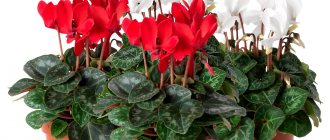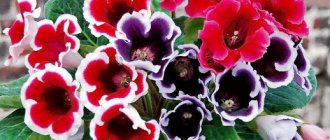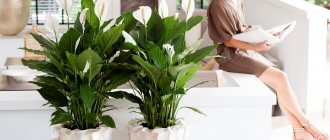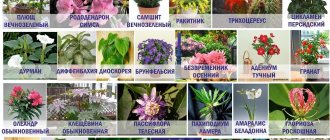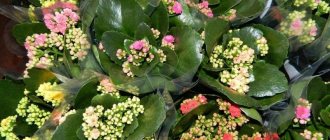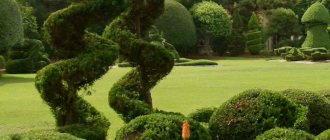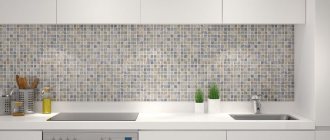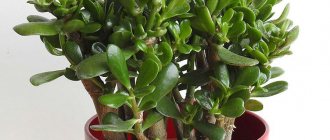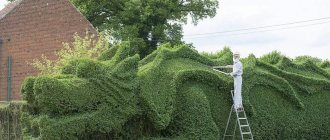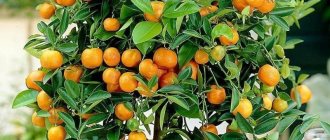Plants with decorative, colorful, large, bright and beautiful leaves add a special accent to the interior of any room. Sometimes you don’t need any other decor if you place a spectacular tree or bush on the table by the sofa in the living room.
Mostly the leaves of indoor plants are pink, but there are also purple and scarlet leaves. If you have long wanted to purchase an unusual bush that can transform a space with its appearance, we bring to your attention a list of beautiful indoor plants with colored leaves. In addition, most of them are not particularly demanding to care for, and therefore will take root well in your home.
Cordilina
A beautiful bush with decorative leaves, belonging to the Agave family and to the category of false palms. In general, there are many species of this plant, but some varieties are especially popular, since their plates are colored in certain shades in different intensities:
- Kiwi - intense crimson border;
- Apical - dark red color;
- Red - leaves, like fruits, can be from dark green to bright red;
- Purple compacta - most leaves are green, only a few have a dirty purple tint;
- Rumba - plates with white veins and scarlet edging;
- Tango is a small and neat tree with a lush tuft of leaves of an unusual brown color.
Caring for the plant does not require any special effort, but for the most decorative type of cordyline, you should follow some simple rules:
- diffused light;
- temperature regime - no higher than 22-23°C;
- moderate watering;
- During the growth period, fertilizing is required.
Colors and shapes of leaves in variegated plants (with photo)
Typically, the color of leaves on plants represents various shades of green, as well as variegated combinations of green with white and other colors. A plant leaf is called variegated, in some areas of which there is an insufficient amount of chlorophyll or no chlorophyll at all. Most often, the most interesting variegation is the result of the work of breeders, who get more and more new patterns and color combinations. The color and shape of the leaves are not interrelated. So, a long leaf can be both green and striped. The heart-shaped leaf can also have different color options.
Pink-variegated species include, for example:
Caladium
Cordyline
Cryptanthus
Hypoestes
The following species are considered red-variegated:
Bloom's Coleus (Coleus blumei, hybrids)
Irezina
Maranta
Tradescantia zebrine
White, cream or yellow variegation is present in some species:
Aglaonema
Chlorophytum sotosum
Euonymus (Eonymus)
Pisonia
The leaves of such species as:
Calathea
Stromanta
Their leaf blade shape depends on the period of plant growth.
Croton (Codiaeum) has a very special pattern in green, yellow and orange-red tones .
Many variegated leaves also differ in certain shapes and patterns:
In some, the edge of the leaf is outlined by a strip of a different color, as in Sansevieria trifasciata.
or Dracaena marginata
Other cultures have a marble pattern, for example:
Dieffenbachia
Scindapsus (Epipremnum)
Hypoestes
The leaves of one type of begonia - Begonia masoniana - are decorated with a black cross.
Look at the various variegated indoor plants in the photo, which shows a variety of colors:
Croton or codiaum
A wonderful plant that pleases with the unusualness of its variegated leaves. However, it is not easy to care for it, since the culture is quite capricious and demanding in terms of living conditions. So that the bush pleases with its beauty, does not lose its decorative effect and does not die, strictly adhere to the following conditions:
- loves bright light, but it is better to protect the plant from direct sunlight;
- temperature conditions are different: in summer - from 20 to 22°C, in winter - not lower than 16°C;
- You need to water regularly, but moderately;
- Be sure to fertilize with complex mineral fertilizer.
Be careful! The leaves and stems of croton secrete poisonous juice, which can cause not the most pleasant consequences: vomiting, indigestion, allergies. Therefore, when working with a plant, you must wear gloves!
Decorative foliage indoor plants: photos and names
If you want to give your home uniqueness and comfort, I advise you to pay attention to landscaping, because it is a living element of decor. Many of the decorative foliage plants are unpretentious, while others require a little tinkering. If you're interested, read on as I briefly talk about caring for each of my favorites.
Aglaonema
Aglaonema
Aglaonema is an unpretentious tropical plant with leaves of different colors. Currently, there are many varieties, including those with bright red and pink leaves, which come to us from Thailand.
Green-leaved aglaonemas are shade-loving, but red-leaved ones require bright, diffused light, otherwise they will lose their beautiful pattern. Despite the fact that these are inhabitants of the tropics, they need to be watered very carefully, after the top layer of soil dries out, otherwise the root system may rot.
aglaonema
The plant requires year-round warm maintenance of at least 16 ° C in winter and loves moist air. If the air in the apartment is too dry, the tips of the leaves of Aglaonema dry out. This is not fatal, but it somewhat spoils the overall appearance, so dry ends need to be carefully trimmed.
For planting, you need a loose substrate with the addition of peat, leaf soil, fine bark, coal, sphagnum moss and perlite. You can buy a ready-made mixture for aroids. Ingoda, I add coconut substrate to purchased peat, which is sold in briquettes.
Codiaum (croton)
Codium
This small tree has many varieties with beautiful bright foliage. In stores you can see specimens with narrow and wide leaves of various colors: green with yellow and reddish spots and stains. The color changes as the leaf ages to become brighter.
Codiaum is a rather whimsical plant. Does not tolerate overdrying or overwatering, requires bright lighting and high air humidity in winter. Under good conditions, it holds the lower leaves for a long time and looks like a lush bush. If the air in the apartment is too dry in winter, it can be affected by spider mites.
codiaum
Codiaum is a poisonous plant, so if you have small children or curious animals who like to chew on everything they can, it is better to avoid it.
The tree loves fertile, loose soil, so when planting, I add peat, garden soil (humus), perlite and coal to the mixture. You can add fine orchid bark to loosen it.
Does not tolerate drafts and low temperatures, grows well at 20...25° C. In winter it feels good under artificial lighting, in summer it needs to be shaded from direct rays of the sun.
Ficus
I now have two ficus trees growing: Benjamina variety Irene and rubber ficus, which I rescued from the Dixie store because it was dying there from drought.
ficus benjamina
Ficus benjamina loves light, careful watering, and timely transplanting into a large container. The Irene variety with curly leaves constantly sheds young leaves, which does not in any way affect its decorative effect. I used to have other varieties that dropped their leaves in the winter due to lack of light.
The rubber ficus is quite shade-tolerant and grows slowly, which makes me very happy. Other Benjamin ficuses had to be abandoned due to their large size.
I also have a dwarf ficus pumila (ficus pumila). This is a small creeping plant with leaves that are rough to the touch. This type of ficus loves high air humidity, so I covered it with moss and from time to time I moisten the moss with a spray bottle.
In general, with the exception of dwarf species, ficuses are unpretentious plants. Their only drawback (for me) is that over time they grow into huge trees that have to be built somewhere. But for some, on the contrary, this is a big plus. If there is enough space in the apartment, why not leave such a beautiful tree?
Sansevieria
Sansevieria is a plant with an unusual appearance. Its long leaves decorate any composition and look great alone. There are also forms with low foliage. There are varieties with green and almost white leaves, with yellow and white leaf edges. In general, the gardener has plenty to choose from, although some varieties will have to be searched for.
Sansevieria
The flower is unpretentious, the main thing is not to overwater it. Does not require frequent fertilizing and replanting; it tolerates the dry air of apartments. Cultivars with green leaves are shade-tolerant, while those with variegated ones are better placed in a well-lit place: the color will be brighter.
For planting, you will need loose soil and a wide but shallow container, since the root system of sansevieria grows in breadth. I recommend this flower to beginning gardeners and those who forget about watering. “Sansa” will survive this. ?
Hoya
Hoya is currently a collectible plant. It has many varieties with beautiful foliage and unusual flowering. These are vines that can be grown as hanging or on a support.
hoya
Hoya's leaves are thick and fleshy, which means that it needs to be watered carefully after the earthen clod dries out. Small flowers, similar to wax, are collected in large clusters and look very unusual. But even without them, hoyas are very decorative, thanks to their unusual foliage, which decorates our homes all year round.
Hoyas can tolerate shade, but then they may not bloom, and variegated varieties will lose their variegation. So it is better to provide them with bright diffused light with shading from direct sunlight. They are undemanding to air humidity.
The soil for planting needs to be loose and breathable with the addition of coal and perlite. In winter, you should limit watering and provide the flower with a cooler room with a temperature of 16...18 ° C, then the hoya will bloom. Although some species bloom at ordinary room temperature.
Begonia
Decorative deciduous begonias are so diverse that it is not so easy to stop at one or two specimens. The color of the leaves varies from silver to red and almost black, while the foliage often has a pattern or bright contrasting “speckles”.
royal begonia
You can buy begonia in a store that sells the most common varieties, or from collectors, if you want something completely unusual, so that it is not like others. ?
Leaf begonias love high humidity, temperature 18...25 ° C, diffused light without direct sunlight that burns them, careful watering after the top layer of soil dries, regular fertilizing with fertilizers for decorative deciduous plants.
For planting, you will need a very loose substrate (peat and a lot of perlite) and a small pot in which it will be easier to control soil moisture. These flowers cannot tolerate overwatering.
They also die at very high temperatures in summer, so if you live in hot climates and don’t have air conditioning, think carefully about whether you need decorative deciduous begonia?
Irezine
Belongs to the amaranth family, uniting as many as 80 species of various plants. The varieties of Linden and Herbst are especially loved by flower growers.
The flower is not poisonous and cleans and oxygenates the air in the room well.
Irezine does not require any special growing conditions, and can “live” well even with novice gardeners. Basics of care:
- sunlight is needed;
- air temperature - from 16 to 25°C;
- you need to water abundantly and regularly;
- timely pruning to maintain decorativeness;
- replanting is carried out after the old container is filled with roots, at least once every 2-3 years.
Indoor monstera flower: home care rules
The name of the species does not play a significant role when performing basic activities for caring for perennials in indoor culture. The above-ground part needs to be periodically trimmed, and the crop itself needs watering, fertilizing and prevention. Reproduction is carried out by seed material, as well as cuttings and well-developed air layering.
Humidity, lighting and temperature
In summer, the ornamental plant tolerates temperature increases up to 29-30°C, but in winter it is best to maintain the temperature at 16-18°C. Despite the fact that a tropical crop can tolerate low humidity levels relatively easily, it is preferable to keep this indicator at high values.
The culture needs sunlight, so it is advisable to place the flower pot with the plant on an east or west window. A perennial of tropical origin does not tolerate direct sunlight, so the above-ground part must be shaded on southern windows.
Selecting a pot and soil
In home floriculture, Monstera reaches a height of 200-230 cm, but the intensity of growth processes does not exceed two to three leaves every year, so there is no need to immediately purchase a pot that is too large. The flower pot must have drainage holes of the required size to drain excess water. Proper transplantation of an adult plant is carried out annually , after winter rest, around April. After replanting, the plant must be provided with support.
As a planting substrate, you need to use soil rich in nutrients and well-retaining moisture. A soil nutrient substrate based on one part of peat , a couple of parts of leaf humus and one part of pure coarse sand or standard perlite has good characteristics. The earth must go through a disinfection cycle. A prerequisite for proper cultivation is the use of sufficient drainage.
Features and timing of pruning
Pruning the top is performed when there is a pronounced slowdown in crop growth and allows you to effectively renew the plant and stimulate the development of side shoots. This procedure must be done with a sharp and clean knife. In indoor tropical monsteras, aerial roots form from each leaf. You cannot cut off aerial roots. They should be placed in soil or water, which improves plant nutrition.
How to feed an indoor flower
At all stages of growth and development, it is important to properly feed the perennial. When applying fertilizers, it is imperative to observe the seasonality rule. Feeding should only be done in spring and summer. In winter, fertilizing is excluded.
You can use both root and foliar fertilizers at least a couple of times a month, using special fertilizers intended for growing plants belonging to the Araceae family. “Gumisol” or “Epin” as complex fertilizers , and for foliar feeding it is best to use “Urea-K6”.
Watering a flower
For irrigation, be sure to use soft and well-settled water at room temperature. It is best to use melted snow, rain or spring water for this purpose. There is no clear schedule determining how often indoor monstera should be watered. Irrigation activities are carried out after the top layer of soil in the pot has dried. Watering in the summer, as well as in spring and early autumn, is carried out quite abundantly. In winter, the nutrient soil substrate should be slightly moist.
What you need to know about monstera aerial roots
At its core, such an organ of the aerial part as aerial roots, in addition to additional nutrition, provides a perennial tropical crop with a kind of support. When performing regular spraying, you must not forget to spray the aerial roots as well. In the presence of dry air and insufficient natural light, it is this above-ground part of the plant that suffers first. If the air in the room is extremely dry, aerial roots should be wrapped in well-moistened sphagnum moss.
Coleus
Where there is no limit to imagination is coleus. In most species, the leaves are painted in bright, catchy shades. There are single-color plates, but there are varieties in which they are painted in several shades at once. These bushes look very beautiful, and they are completely easy to care for. Moreover, in the summer they can be taken out into the garden and sent indoors for the winter.
Coleus are often grown on balconies.
The basics of care include:
- needs a lot of bright sunlight, but it is better to shade the flower from direct rays;
- summer temperature - from 18 to 20°C, but not lower than 12°C;
- water regularly and quite abundantly;
- to maintain the decorative effect, the crown must be correctly shaped to create a lush bush;
- replant once every 3 or 4 years;
- With the onset of spring and until autumn, coleus plants are fertilized once a week.
Graceful cordyline
For many, this representative of the Agave family and false palms has long become a symbol of grace. Cordyline fruticosa , formerly known as Cordyline terminalis, is truly a proud house pet. She has become famous for her beauty as one of the most fashionable representatives of decorative foliage plants with interesting silhouettes today, but the colors of this beauty are by no means standard.
Cordyline fruticosa. © floradania
The color range of cordilines can be very different, sometimes more variegated, sometimes more modest, with shade transitions and subtle “strokes” noticeable only close up. But even the simplest cordyline varieties are always characterized by multi-color combinations. Even the green color on the leaves occurs in at least three variations - from light to dark shades, and the light ones sometimes seem almost yellow or mustard.
But the main trump card of Cordiline is the addition of different stripes of green with red, luminous, bright details. Ruby, cherry, dark red shades of the border and stripes are surprisingly rich and rare. Just to appreciate all the colorful beauty of this plant, you need to be patient: cordyline reveals its palette only with time.
Cordyline can be very different. Spreading varieties or compact, slender, with erect and slightly strict shoots of Cordyline are equally beautiful. With a height of 20 to 50 cm for compact varieties up to 50-100 cm for the largest ones, Cordyline is always elegant.
The weakly defined stem in some species and more powerful branching shoots that give a palm-like appearance in others are covered with beautiful leaves, never exceeding 1.5 cm in diameter. They are often confused with dracaenas, but these beauties are only false palms. They form root suckers and are much more graceful.
Cordyline leaves are elongated, lanceolate, narrower or wider, with a gracefully pointed edge, they seem to be the epitome of elegance. The leaves sit on short petioles or “hug” the shoot in pairs, and can reach a length of either a modest 10 cm or almost half a meter. Relief veins stand out on their surface.
The flowering of Cordyline is not too remarkable: white or reddish flowers in large loose panicles are airy and decorate the plant, but still do not distract attention from the beauty of the foliage.
Cordilina feels great both in bright places (though she needs protection from direct sunlight) and in semi-shaded interior lighting. It is inside the rooms that Cordyline truly reveals its richness of shades of green and all the beauty of its silhouette.
Warm living rooms in terms of temperature, standard regular watering with soft water and regular feeding once every 2 weeks are quite suitable for her. But what can really cause difficulties in growing this aristocrat is her love for high air humidity.
Cordyline fruticosa. © floradania
The role of cordilina in the interior:
- as a soloist, a beautiful accent;
- in decorating tabletops and chests of drawers;
- in groups with other Cordylines.
This plant with colored leaves is characterized by one rare talent - the ability to visually expand space, bring a feeling of spaciousness and freedom to rooms. Cordilina is modest and elegant, regal and surprisingly harmonious. It can also be used in the living room, but it is simply irreplaceable for decorating bedrooms, where it has a surprisingly calming and optimistic effect. Cordyline feels good in greenhouses and gives spaciousness to small rooms. It reveals its beauty most favorably in a bright interior.
Varietal diversity of Cordyline: different varieties of the plant flaunt darker or brighter spots, a wide or narrow border; the most popular are Cordyline "Kiwi" with a thin red edge and golden stripes along wide leaf blades, the scarlet-ruby king of the variegated varieties "Red Edge" and the Cordyline variety with leaf blades divided into two parts - yellow and green - with a purple border "Bicolor" .
Aglaonema
A species of tropical representatives that are very fond of professional flower growers and fans of indoor plants. Some varieties have beautiful wide leaf blades:
- Rounded - on a dark green background, thin red, carmine or pink stripes running along the veins are clearly visible.
- Red - Foliage can be red, pink or beet green.
- Crete is a fiery scarlet shade, on which green spots of varying degrees of intensity appear over time.
- Butterfly - combinations of red, yellow and deep marsh tones on one plate.
- Taivoli - the shade of the edging varies from pale pink to bright scarlet (the older the plant, the brighter the outline).
- Painted - a pattern on the leaves in the form of spots, varies in the silver-blue range.
Rules for keeping at home:
- diffused sunlight, slight shading;
- in winter without watering it can withstand up to +10 -15°C, in summer - +24°C;
- in the warm season, the soil should be moistened; in winter, watering should be reduced to once every 10 days;
- transplantation - once every 3 years.
Monstera spp.
Monstera attractive or delicious (Monstera deliciosa)
Central America is the birthplace of this tropical beauty. In the humid jungle, located 1000 m above sea level, the cylindrical stems, up to seven centimeters in diameter, of climbing vines can overcome a height of twelve meters. The leathery, dissected leaves with holes on these exotic beauties resemble a heart measuring up to sixty centimeters.
Blooms with white buds. Fragrant, sweet berries ripen on twenty-five centimeter ears and turn into a delicacy. Residents of the tropics use the fruits of Monstera deliciosa in their diet.
The monstera flower, thanks to its attractive and charming appearance, is increasingly decorating and landscaping living spaces.
Monstera deliciosa borsigiana
Compact non-flowering indoor vine. An artificially bred variety from Mexican ancestors. Thin stems are decorated with thirty centimeter heart-shaped, evenly cut leaves.
Monstera adanconi
Representatives of this species grow in the tropical forests between Brazil and Costa Rica. They are located on trees, reaching eight meters in height. Ovate thin leaves up to half a meter long and up to forty centimeters wide. The entire area of the sheet is decorated with holes.
It is not possible to see the flowering of Monstera Adanson at home, but the ideal moment would be the appearance of a light yellow ten-centimeter ear.
Monstera marbled or variegated (Monstera variegata)
Native to South America and East India. A distinctive feature of this exotic is the combination of green and beige colors on the leaves and stems.
Monstera Alba or variegata (Monstera variegata)
The most beautiful and more capricious variety of monstera. The variegation of leaves in a combination of dark green and white colors makes it especially attractive. On a multi-colored stem, the first leaves are solid, and subsequent ones become more openwork and divided. The lighting for Monstera Alba should be bright and the room warm.
Monstera oblique or unequal-sided (Monstera obligate)
Lanceolate, ellipse-shaped, shiny leaves on thirteen-centimeter petioles that are not symmetrically located on the stem can reach 25 cm. The central vein on the leaf plate is located obliquely. The peduncle, 8 cm high, presents the inflorescence in the form of a few-flowered four-centimeter spadix.
Begonia Royal
A hybrid species of the Begoniaceae family. The flower is distinguished by asymmetrical leaves, which have a beautiful pattern and unusual color, varying depending on the varietal characteristics. The shades of the leaf plates can be completely different: cherry, scarlet, pale pink, violet-green pattern and burgundy edging, rich red and others.
Basic growing rules:
- thanks to the large amount of diffused sunlight, the bush will delight with a bright crown;
- optimal temperature - 25°C;
- loves moist soil, but does not tolerate stagnation of moisture in the pot;
- perfectly tolerates frequent spraying;
- requires regular feeding.
Hypoestes
A genus of tropical plants of the Acanthus family. It has amazing foliage color, resembling a face covered with rainbow freckles. Perfect for those who like brightness in the interior. This is a type of branched shrub with unusual leaf blades. The main feature of the plant is the presence on the surface of many dots of different shades: red, white, pink, purple. Well, just like freckles!
The bush is quite unpretentious, it is very easy to care for:
- grows both in small rooms (but with good lighting!) and in the garden with other moisture-loving ornamental plants;
- temperature - from 22 to 25°C, but not less than 17 degrees;
- watering should be plentiful;
- To make the foliage brighter and the shade more clearly visible, use fertilizer with a high potassium content.
Botanical description
The liana in its natural environment and indoor conditions has a thick climbing stem that can grow up to 5-6 meters in height. It contains aerial roots. It is popular among flower growers due to its large, beautiful carved leaves. Young leaves are pressed to the stem and are whole.
An adult vine has perforated large (up to 45 cm) leaf plates. If the plant is supported, it reaches gigantic proportions in offices and city apartments.
Maranta
A tropical flower with an unusual color. The foliage itself is bright green, with clearly visible spots and veins of a red hue. The plant does not require special care. The main thing is to maintain optimal temperature conditions, water in a timely manner, trim dry leaves and replant 2 times a year with the arrival of spring.
An interesting feature of arrowroot is that the upper surface of the leaves is much brighter than the lower surface. This is more than noticeable when the bush lifts its leaves in the evening and folds them slightly.
Decorative foliage plants
This is the largest group of indoor plants. It unites more than one hundred and fifty types of flowers. Their main feature is beautiful, decorative leaves. They can be different shades of green, or they can have an unusual color. And green leaves are also often not monochromatic, but with stripes or spots of different shades of white, yellow, and purple.
The leaves of decorative deciduous flowers come in a variety of colors: red, purple, yellow. Some may change color depending on the time of year or lighting.
Decorative foliage is an excellent interior decoration. For example, I like these flowers more than others. Among the decorative deciduous ones there are specimens that can compete with the decorative flowering ones. After all, leaves can be of very unusual shapes: dissected, lobed, jagged, oval, linear. Jagged or wavy edges of the leaves are also one of the characteristics of these flowers.
They usually have small flowers that appear 1-2 times a year and are not particularly decorative.
It is these flowers that easily take root in almost any apartment conditions. They are not as demanding on a certain level of lighting as beautifully flowering (decorative flowering) ones. True, some specimens can change the color of the leaves depending on where they are located - in the sun or in the shade. But the flowers of this group are quite demanding regarding proper watering and air temperature. They may also lose their decorative properties due to lack of nutrients. For many, the tips of the leaves dry out and darken.
In this group, plants can also be divided into subgroups: trees, false palms, bushy plants, vines, ampelous, ground cover, flowers with spear-shaped leaves and flowers with grass-like leaves, as well as carnivorous plants.
Among the prominent representatives of decorative flowering plants: ficus, dieffenbachia, bamboo, fern, arrowroot, palm, philodendron.
Ginura
An evergreen subshrub with delicate velvety leaves, which are sometimes colored purple underneath. This creates an unusual feeling. The veins on the plates can also be painted in a similar color.
The plant is not capricious, great for beginner gardeners:
- bright light, but in the hot season it is better to shade the bush;
- temperature - from 18 to 24°C;
- water abundantly as soon as the top layer of soil dries out;
- feed during active growth once every two weeks.
Subscribe to our Social networks
Monstera care
Before you get a monstera, keep in mind that even in an apartment the tropical giant grows to impressive sizes. So be sure to make sure to give her enough space in the room.
Temperature
Like its tropical relatives, Monstera loves warm climates and does not tolerate winter frosts. Make sure that the temperature in the room does not fall below 16 degrees, but in the summer it can easily tolerate even 25.
Lighting
The spreading and lush monstera, contrary to popular belief, does not require too much sun, and direct rays leave burns. It tolerates shaded areas well, which is why it has taken root in apartments. But keep in mind that if there is too much shadow, the leaves will grow paler, smaller and not with such deep slits.
Watering
But the monstera needs as much water as possible, because soft and warm tropical showers will have to be replaced on its own. The flower needs plenty of watering, but do not over-moisten the soil. It’s easy to notice from the monstera that something is wrong: if there is too much moisture, it “cries”: drops simply collect on the leaves.
Don’t forget about spraying, without which the leaves dry out and turn yellow in the heat. Wash the plates with warm water to remove dust and dirt, but use only soft water, otherwise whitish spots will remain. In winter, reduce the intensity and frequency of water procedures, but do not abandon them completely.
Fertilizers and fertilizing
Monstera is a powerful and strong plant with large leaves, so feeding is important for its appearance during active growth: from mid-spring to the end of summer. You don't have to reinvent the wheel: specialized mixtures for decorative deciduous species are suitable. But in winter it is not advisable to fertilize the monstera, otherwise it will begin to grow more actively, but the leaves will be sluggish and weak.
Trimming
The tropical guest does not need regular pruning, but as a vine it requires support for growth. If you want to form a spreading and voluminous plant, cut the stem once or twice at the very beginning.
The peculiarity of Monstera is its large number of long and strong aerial roots, with which it tries to fix itself on the base. Travelers used to mistake them for the tentacles of tropical monsters. But in reality they are very delicate and gentle, so they require careful handling.
As it grows, it is recommended to root all adventitious roots in a pot, otherwise the flower may even grow to the protrusions and roughness of the wall. And then removing it carefully so as not to damage it is almost impossible.
